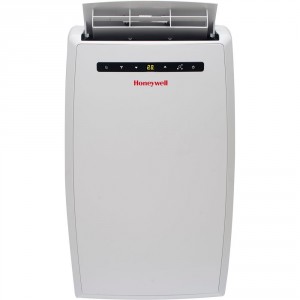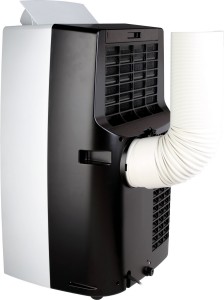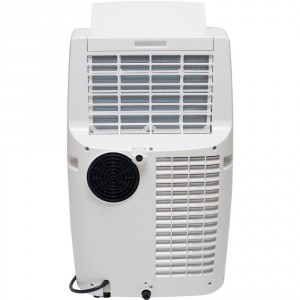
Portable Air Conditioner
Pam and I spend much of our full time RV living in warmer climates. We have wondered if a portable AC unit would help cool the rig down when it’s in the nineties and with high humidity. So, we started looking at portable air conditioner reviews to see if we could find one that would work for us.
Our fifth wheel had two AC units: one was a 15k Btu unit, and the other was a 13.5K unit. They were installed in a ducted system, which makes the system quieter, but you do lose some cooling in the transfer. They mostly did a great job, but when you are in south Florida in the summer, they ran an awful lot. Keeping it in the low 70’s meant running them constantly. Doing that risks freezing up the cooling coils, thereby possibly damaging the unit. So to get them to cycle, thermostat settings stayed in the upper seventies during the day.
Our current RV, a Newmar 2023 Superstar, is in a similar situation and is also longer than the fifth-wheel RV. On our previous RV, a 2021 Tiffin Allegro Open Road, we had the rear AC unit go out when the temperatures were in the high nineties. We had to get a portable air conditioner quickly.
We visited our local home store and found a HiSense portable air conditioner that needed a window to vent. That was not a problem, as the windows in the slideouts work well for adapting the hose assembly to fit. Within hours of the roof AC unit failing, we had supplemental cooling. That worked well till we got a replacement AC unit installed.
Last summer, while in Texas and with our 2023 Newmar Superstar, we needed to use the portable air conditioner unit again. It was necessary to supplement the two 15k BTU AC units. We had temperatures in the hundreds! We installed the portable AC unit again using a slideout window. It really helped cool the front of the RV where the temperatures were the highest. The HiSense portable AC unit performed admirably!
If you have been thinking of a portable air conditioner unit as we did, perhaps the information we share here will also help you consider this option. It may save you some time when you are looking at portable air conditioner reviews.
Think of portable air conditioners as the cooling choice of last resort. They’re better than a fan, but not much. That’s what Consumer Reports discovered in its tests of eight portable air conditioners that, despite their claims, barely got a room below sweltering, let alone 78 degrees. That’s considered the upper threshold of indoor comfort.
We found our HiSense to perform exceptionally well, given some questionable reviews. That may be because RVs are a much more confined space, and with the roof AC units running too, we have found our performs very well.
Portable air conditioners are intended for homes in which window configurations or building regulations prevent the installation of window units. They can also be a consideration for small rooms like in an RV. But getting one is a compromise you may not want to make because they’re typically bigger, noisier, more expensive, and use more energy. Retailers report that dissatisfied customers return many portable air conditioners each season.
How they work
Unlike a window air conditioner, all the mechanical parts of a portable air conditioner sit in the room you’re trying to cool. This contributes to the noise and less-than-capable cooling, as the portable unit uses conditioned air from the room to cool the condenser and exhausts the hot air out an ungainly exhaust hose that resembles a dryer vent.
That creates negative pressure, causing unconditioned warm air from surrounding rooms or outdoors to be drawn into the room you’re trying to keep cool. Now they have dual hose units that help with this situation, but they tend to be a few hundred dollars more than the single hose units. If you are going to spend $500 – $800 for one of these, why not just get a better roof unit?

Portable AC Unit with Single Vent Hose
How portable?
And it’s debatable how portable they are since once the hose is connected to the kit in the window, you won’t want to move the unit, especially since they typically weigh 50 to 80 pounds. While they have wheels, portable air conditioners can be difficult to roll on carpets and over raised thresholds between rooms. They also need their space—the hose is 5 to 7 feet long, and the air conditioner must be positioned away from any walls or furniture that may block its airflow. This can make it a terrible choice for an RV!
How they test
Consumer Reports tests measured how long it takes a portable air conditioner to lower the temperature in a room appropriate for its claimed size from 90 degrees to 75. After 100 minutes, few made it to even 80. But if you have no alternative, consider the HiSense at $220 for its lower price.

Back of a Portable AC Unit
While Consumer Reports tests portable air conditioners like window units, most manufacturers don’t. The Department of Energy is reviewing the current industry test for portable air conditioner capacity and efficiency. The current test doesn’t account for the often significant leakage and transfer of hot air into the space being cooled.
One alternative being investigated by the DOE is that the industry adopt the window air conditioner test for portables because it more accurately measures actual cooling. This would make it easier for consumers to compare portable and window air conditioners. In the meantime, don’t assume that a portable air conditioner rated at 5,000 to 15,000 Btu will cool like similarly rated window or roof unit models.
If you have no other option than upgrading your roof units, this can be a way to get by during the really hot months that you have to endure. The better option is to live in a cooler climate. After all, if you live in an RV, you can move your home wherever you want. For us, we are located where we are for specific reasons, and we kind of have to stay put. But come winter, we’ll be much happier!!
We hope this helps you as you consider keeping cool in your RV. Please leave a comment if you found this review helpful. Let us know what you decided to do.
Please leave a comment or question before you go!
Happy travels,
Howard and Pam









23 comments
Skip to comment form
A lot of time on the web, I saw many well-respected bloggers speak highly of this product. Thanks for sharing. I will recommend this product to my family.
I love that you talked about how you should consider reading reviews to gather resourceful information about your needs. My uncle mentioned last night that he and his friends were hoping to find a portable air conditioner that could offer an efficient cooling system for their home. He asked if I had any idea what would be the best option to consider. Thanks to this informative article. I’ll tell him they can consult a trusted hardware store for more information.
Good Read…Having an interesting your posts…Thanks a lot for sharing!! Dale’s AC
That’s good to know that the RV will work with a portable air conditioner. My brother is complaining about how his is hot. I’ll recommend he gets one.
I bought one after reading about this on this site…it’s working great ! I also suggested one for my family members.. Thanks a lot to this website !
I want to use a portable air conditioner as help with my one roof air-conditioner for mmy fifth wheel camper .that has 50 amps .or order another roof top . It that’s expensive.so is I get a good 8000 btu just to help out in bathroom and. Bedroom.
Author
Hi Richard!
Thanks for stopping by our website!
If you have a 15 to 20 amp circuit that will accommodate the portable AC unit, then that may be a good option for you. If your 5th wheel is already wired for the second unit, that would be a cleaner install.
You can buy reconditioned roof units that are half the price of a new one. That may be another option. If you can install it yourself you can save yourself the labor costs. That is the larger portion of a roof AC unit install.
Good luck!
Thanks for the info, I am actually looking to install one wall AC in my office.
Author
Thanks for stopping by Darrel!
I’ve purchase a Danby 6000 btu floor a/c, I have only a 30 amp service , but I have 2 roof a/c , ones a 15000 & the other is 13500 btu, since I can’t run both on a 30 amp service, im going to try using the danby 6000 with my 15000, the Danby pulls 6 amps, 672 watts,I’m in quartzsite AZ, & hope to cool my 2018 Montana 5th wheel.
Author
Hi Joe!
Can you plug the floor AC unit into another circuit in the pedestal that your 30 amp shore power cord is plugged into? Perhaps into the 20 amp receptacle if it has one? Even with the smaller AC unit, you are still pushing it. Don’t forget your converter is running too!
Hello,
So, my husband and I are moving into our RV. We live in central Texas. Our Rv is a 30 amp. We have two dogs, we wanted to buy a portable air conditioner to help our roof top air conditioner, so it’s not running all day. We are also picking up a MarCell Monitor.
We thought we would plug the portable air conditioner right into the power source rather then plug it into our RV. Do you have any recommendations. We will be living in our camper for at least 6 months.
Author
Hi Kelly!
You can check out the one I recommended here in this post at http://amzn.to/1ncbm01
Keep cool!!
Thanks for the fast reply ! My portable AC unit is 11000 BTUs so hopefully it works well . Thanks again !
Hey I have a portable air-conditioner which requires 1560 watts to run according to the plug on it. I’m wondering if it’s ok to plug that into a plug in the bedroom of my camper without doing any damage. I can then run the hoses through the bedroom window. I have a 2004 Salem le with 30amp service . Reasoning for this is my rooftop AC unit is broken and I already have a portable AC unit at home. A reply to this would be greatly appreciated!!
Author
Hi Kerry!
Thanks for stopping by our website!
Okay! If the AC unit is plugged into a 15 amp circuit (you will know by looking at the breaker protecting the bedroom plug) you have 1800 watts available at 120 volts. As long as nothing else is plugged in and being used you should be okay. If it is a 20 amp circuit then you are fine.
You have a total of 3600 watts available with a 30 amp RV service. That AC unit will be almost half of that so watch your electrical usage. It is not that different from your roof AC depending on how many BTU’s it offers.
Good read. Having an interesting your posts. Thanks, a lot of sharing! kudos!
Could you use a winder a/c and your roof air at the same Time? We are in Arizona and our 15000 btu foor air is not keeping up.
Author
Thanks for stopping by our website Jim!
I see other RVers using small window AC units. As long as you are not exceeding the electrical capacity of your RV while running both.
For 30 amp RV’s you only have 3,600 watts available. A 15k unit and a small window AC unit would most likely, depending on the size, get pretty close to 3,600 watts with both running, perhaps even exceed that.
Now a 50 amp RV would not have a problem as long as you are not exceeding the electrical capacities of any one branch circuit.
Hi Howard and Pam, your article came in handy for my situation. I’m a full timer for the last 4 years. I’ve had motor homes and travel trailers. My last travel trailer was a very small 15 footer. It had a 6,000 btu window unit which served me just fine. When the floor rotted out from under me I decided to convert an enclosed cargo trailer. AC was one of my concerns, I wanted something unobtrusive, as I wanted to retain the stealth of it looking like just a cargo trailer. Most of the time I’m at one of my three son’s visiting them and all my grandchildren. So 90% of the time I have external power. I was considering one of those portable units and was reading reviews on several of them. I was going to put a hole in the flooring to vent the unit. After reading your review I think i’m just going to go with the roof unit that will fit in the vent that is already there. Thanks for your research. Juan
Author
Thanks for sharing Juan!
Be sure the roof structure can handle the weight of a 100 lb unit as well as the vibration it creates upon startup. I have a Diamond Cargo trailer and toyed with the same idea but they said the roof, as constructed, would not accommodate a rood AC unit. Hopefully, yours can.
I need to to thank you for this wonderful read!! I certainly enjoyed
every bit of it. I’ve got you book-marked to check out new stuff you post…
Author
Thanks Caitlyn! Living in Mesa, Arizona in the summer, you really know what heat is!! We spent a winter there and left in mid-April. It was already hot then, and dry too! Enjoy your winter and thanks for checking in!